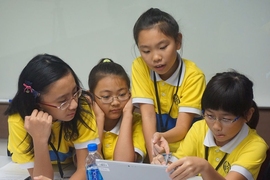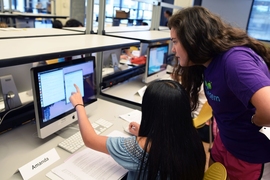On Saturday, Aug. 19, the MIT Women in Chemistry (WIC) held their second annual Scientist for a Day camp for local middle school girls.
The well-attended event provided participants with a sampling of hands-on science activities led by female graduate students in MIT's Department of Chemistry. Over the course of the three-and-a-half hour experience, the girls experimented with polymers used in every-day materials, extracted DNA from strawberries and fluorescent molecules from spinach, simulated the greenhouse effect and its origin in our environment, made ice cream using liquid nitrogen, and more. "It was quite clear that all had a great time," said department head and Robert R. Taylor Professor Timothy F. Jamison. "I would be very surprised if [the WIC volunteers] have not inspired many or all of these girls to start or to continue on their paths in science."
The afternoon of scientific exploration proved to be rewarding not just for the middle-school girls, but also for the women who organized the event. "I really liked being reminded of what I must have been like before I knew as much about science as I do now," said graduate student and WIC outreach chair Krysta Dummit. "[I also] liked thinking about all the science they had yet to discover."
Graduate student voluteer Amanda Stubbs regards the event as an opportunity to pay it forward, remembering a defining moment in her own middle school experience that ultimately led her to where she is today. "When I was in middle school I went to a camp that was directed at girls to encourage them to go into STEM fields by talking about different possible careers; this experience was a helpful influence when I was eventually selecting my major as an undergraduate," Stubbs recalled. "I want to do everything I can to encourage more women to pursue chemistry; seeing them achieve the tasks we laid out for them and being excited about what they had accomplished was very rewarding."
The volunteers succeeded in orchestrating a wonderful event that truly got its participants excited about chemistry by putting the experiments right into their hands. "My favorite moment was watching the girls thoroughly smash a bunch of strawberries," said Dummit. "They were so enthusiastic about it. I think it's really important to let kids play with science, rather than just reading about it."
Liquid nitrogen ice cream also proved to be a hit among the crowd. "My favorite moment was making liquid nitrogen ice cream with the girls," said Stubbs. "They were excited and it brought together two of my favorite things: science and ice cream!"
By orchestrating this event and others like it, MIT Women in Chemistry continue to take their role as influencers of the next generation of female STEM students with a significant amount of gravitas. This fulfilling, educational, and, most importantly, fun experience succeded in raising awareness as to just how magnificent the pursuit of chemistry can be.




















